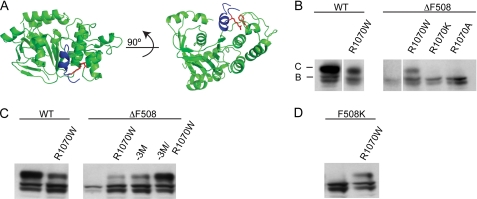FIGURE 6.
NBD-TMD interactions in CFTR maturation. Mutations in ICL4 at position 1070 were evaluated for effects on the trafficking of wild type, ΔF508, and F508K CFTR, transiently expressed in HEK293 cells. As previously described, the presence of the higher molecular weight band, Band C, is indicative of proper folding and trafficking to the Golgi. A, a model of ICL4-NBD1 interactions was derived from sequence alignments and the Sav1866 crystal structure (2HYD). NBD is shown in green, and ICL4 is shown in blue. The Phe-508 and Arg-1070 residue side chains are shown in red. Two views, rotated by 90 degrees are shown. B, Western blots show the effects of the ICL4 Arg-1070 mutations on the trafficking of wild type, ΔF508, and F508K CFTR. C, the R1070W and -3M suppressor mutations were evaluated for their ability to rescue the ΔF508 mutation either independently or in combination. The inclusion of the -3M and R1070W mutations in combination rescued more ΔF508 CFTR than either suppressor set alone. Cells were cultured at 37 °C and evaluated by Western blotting using the M3A7 antibody. D, trafficking of the F508K missense protein was evaluated with the R1070W mutation. Trafficking of F508K was partially rescued by the R1070W mutation. Data shown are representative of at least four experiments.

